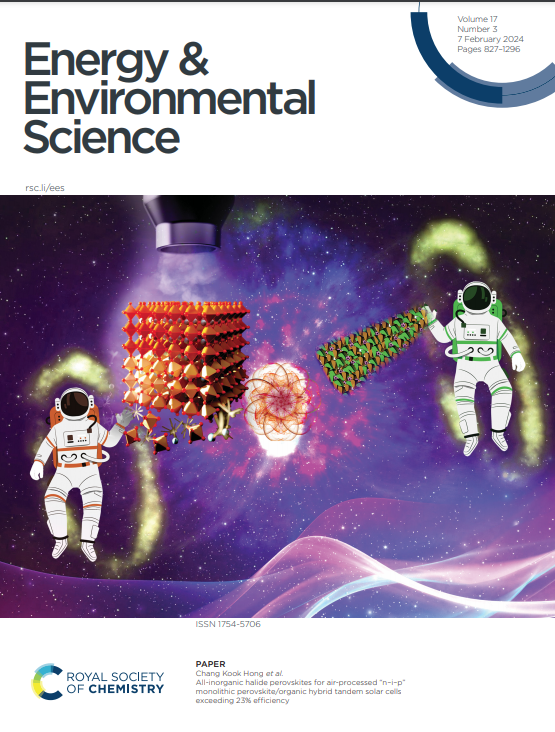Customizing vertical electrodeposition orientation and interfacial solvation to enable magnesium metal anodes with ultrahigh areal capacity
IF 32.4
1区 材料科学
Q1 CHEMISTRY, MULTIDISCIPLINARY
引用次数: 0
Abstract
Magnesium metal batteries (MMBs) are considered as a promising next-generation battery system due to the high theoretical capacity and element abundance of Mg anode. However, the potential interfacial passivation, sluggish desolvation kinetics and dendrite formation severely constrain the cycling stability of MMBs. In this work, we developed 3-bromofluorobenzene (BrFB) as a facet-termination additive in conventional electrolyte to construct highly crystallographic-oriented electrodeposition and modulate interfacial solvation structure of Mg2+. This additive enables to customize the vertical electrodeposition of Mg with preferential orientation of (110) crystal planes. The dipole-dipole interaction between solvent and BrFB induces the weakened shielding effect towards Mg2+ and enhances the reaction kinetics at electrolyte/electrode interface. The in-situ construction of Br/F hybrid interface during cycling facilitates the suppression of parasitic reaction and dendrite proliferation under extreme operating condition. The symmetric cells exhibit the plating/stripping cycling under ultra-high areal capacity of 30 mAh cm-2 with exceptional Mg utilization rate of 89%, ultra-long cycling over 7000 h with a low overpotential less than 190 mV, and stable cycling over 2800 h at a low temperature of -20 °C. The asymmetric cells enable the significantly enhanced average coulombic efficiency of 98.15% over 1800 cycles. The Mg||CuS full cell exhibits a high reversible capacity around 200 mAh g-1 and excellent rate performance. The synergistic customization of solvation structure, solid electrolyte interphase and preferred electrodeposition orientation offers a promising strategy for developing highly durable Mg metal anodes for practical MMBs.定制垂直电沉积方向和界面溶剂化,使金属镁阳极具有超高面积容量
镁金属电池因其具有较高的理论容量和镁阳极元素丰度而被认为是一种很有前途的新一代电池系统。然而,潜在的界面钝化、缓慢的脱溶动力学和枝晶的形成严重限制了MMBs的循环稳定性。在这项工作中,我们开发了3-溴氟苯(BrFB)作为一种面终止添加剂,在传统的电解质中构建了高度晶体取向的电沉积和调节Mg2+的界面溶剂化结构。该添加剂能够定制Mg的垂直电沉积,具有(110)晶体平面的优先取向。溶剂与BrFB之间的偶极-偶极相互作用减弱了对Mg2+的屏蔽作用,提高了电解质/电极界面的反应动力学。在循环过程中原位构建Br/F杂化界面有助于抑制极端工况下的寄生反应和枝晶增殖。该对称电池在30 mAh cm-2的超高面积容量下具有镀/剥离循环,Mg利用率高达89%,超长循环超过7000 h,过电位低于190 mV,在-20℃的低温下稳定循环超过2800 h。非对称电池使平均库仑效率在1800次循环中显著提高98.15%。Mg|| cu全电池具有约200 mAh g-1的高可逆容量和优异的倍率性能。溶剂化结构、固体电解质界面相和首选电沉积方向的协同定制为开发高耐用的Mg金属阳极提供了一个有前途的策略。
本文章由计算机程序翻译,如有差异,请以英文原文为准。
求助全文
约1分钟内获得全文
求助全文
来源期刊

Energy & Environmental Science
化学-工程:化工
CiteScore
50.50
自引率
2.20%
发文量
349
审稿时长
2.2 months
期刊介绍:
Energy & Environmental Science, a peer-reviewed scientific journal, publishes original research and review articles covering interdisciplinary topics in the (bio)chemical and (bio)physical sciences, as well as chemical engineering disciplines. Published monthly by the Royal Society of Chemistry (RSC), a not-for-profit publisher, Energy & Environmental Science is recognized as a leading journal. It boasts an impressive impact factor of 8.500 as of 2009, ranking 8th among 140 journals in the category "Chemistry, Multidisciplinary," second among 71 journals in "Energy & Fuels," second among 128 journals in "Engineering, Chemical," and first among 181 scientific journals in "Environmental Sciences."
Energy & Environmental Science publishes various types of articles, including Research Papers (original scientific work), Review Articles, Perspectives, and Minireviews (feature review-type articles of broad interest), Communications (original scientific work of an urgent nature), Opinions (personal, often speculative viewpoints or hypotheses on current topics), and Analysis Articles (in-depth examination of energy-related issues).
 求助内容:
求助内容: 应助结果提醒方式:
应助结果提醒方式:


